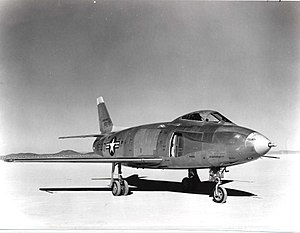North American YF-93
| YF-93 | |
|---|---|
 |
|
| The first YF-93A with NACA inlets | |
| Role | Fighter |
| Manufacturer | North American Aviation |
| First flight | 24 January 1950 |
| Introduction | Experimental |
| Retired | 1956 |
| Primary users |
United States Air Force NACA |
| Number built | 2 |
| Unit cost |
US$11.5 million for the program
|
| Developed from | F-86 Sabre |
The North American YF-93 was an American fighter development of the F-86 Sabre that emerged as a radically different variant that received its own designation. Two were built and flown before the project was eventually canceled.
In 1947, North American Aviation began a design study, NA-157, to create a true "penetration fighter" to meet the requirements of a long-range version of its F-86A Sabre. In order to accommodate more fuel, a much larger F-86A was envisioned, eventually able to carry 1,961 US gallons (7,420 l), both internally and with two 200-US-gallon (760 l) underwing drop tanks. The new variant possessed a theoretical unrefuelled range of over 2,000 nmi (2,300 mi; 3,700 km), twice that of the standard production F-86A. The resultant fighter originally designated the F-86C was intended to compete with the XF-88 Voodoo and Lockheed XF-90 to fulfill the USAF's Penetration Fighter requirement for a bomber escort.
The F-86C was much larger and heavier, weighing in at 10,640 lb (4,830 kg) more than its antecedent. The increased weight and girth necessitated a dual-wheel main landing gear, increased wing area and a more powerful engine, the Pratt & Whitney J48 rated at 6,250 lbf (27.8 kN) static thrust and 8,750 lbf (38.9 kN) thrust available in afterburner. With the SCR-720 search radar and six 20 mm (.79 in) cannon mounted in the nose where the air intake was on the F-86A, the engineers designed a novel set of flush-mounted NACA inlets. A "wasp waist" was also incorporated in the fuselage.
In December 1947, the Air Force ordered two prototype NA-157s and, considering the many changes to the F-86, redesignated it YF-93A. The first prototype was built with the NACA inlet ducts; the second aircraft had more conventional intakes. Six months later, the initial contract was followed up with an order for 118 F-93A-NAs. In 1949, the production order was abruptly canceled as priorities had shifted dramatically following the testing of the ground-breaking Boeing B-47 which reputedly would not need an escort due to its high speed capabilities. With the prototype YF-93As just coming off the production line, the USAF took over the project.
...
Wikipedia
